CHP Also Targets Traffic of Different Sort : Law enforcement: Orange County’s first canine Highway Patrol officer points up the agency’s involvement in drug interdiction.
SANTA ANA — Rocco, a black-haired German shepherd with a keen sense of smell and a full set of teeth, has been training to become the California Highway Patrol’s first canine officer in Orange County. The dog’s arrival will highlight a task not usually associated with the traffic enforcement agency: drug interdiction.
“Narcotics have to go from one point to another, and quite often they’re transported on the freeways,” said CHP Lt. Rick Criner. “Rocco will make the job (of drug interdiction) much simpler and much more effective.”
Since the mid-1980s, the CHP--the state’s main traffic enforcer--has increased its role as a drug enforcement agency, allocating millions of dollars to the training of officers, acquiring dope-sniffing dogs and joining local and federal drug task forces.
“I think the public still regards the Highway Patrol as just a traffic enforcement agency, but we have expanded our activities into . . . drug enforcement,” said Sam Haynes, a CHP spokesman in Sacramento.
The change to a more vigorous drug program occurred about five years ago, when law enforcement officials started recognizing that California was becoming the distribution hub for large and sophisticated narcotics trafficking rings.
Most of the drugs, officials said, were being transported on the state’s highways. It’s a problem that seems to be getting worse--particularly in the Southland, dubbed the “distribution capital of the nation” by the Drug Enforcement Administration.
“The most current trend is . . . big-rigs and large trucks hauling quantities of drugs,” said Ralph B. Lochridge, a spokesman in the DEA’s Los Angeles office. “It boggles the mind as to how trucks out there are transporting cocaine” on the state highways.
Because of the problem, DEA officials approached the Highway Patrol and suggested a narcotics training program for its officers.
“They wanted to increase the awareness among the officers to the increased use of the highways for the purposes of transporting drugs,” Haynes said. “They wanted to show them what was out there and what to look for.”
The extensive training programs for officers are becoming required. Currently, more than 90% of the patrol officers have been trained in the DEA’s nationwide Pipeline program, which is now part of the academy curriculum for recruits.
Officers who have shown a special knack for drug enforcement are often chosen to work undercover narcotics investigations--once off limits to CHP officers. Haynes said there are dozens of such officers working, away from the jurisdiction of the highways, with local and federal task forces.
As a result of the cooperative spirit, CHP officers have joined in four multi-kilogram cocaine busts in the past two weeks alone. Last October, the agency made one of its largest busts when an officer stopped two trucks and 1,400 pounds of cocaine was found in a concealed compartment.
The number of arrests and seizures has climbed dramatically in the past five years, officials said.
As the CHP entered the fray of the drug war, it also positioned itself to reap the rewards of the battle in the form of asset forfeitures.
Like many law enforcement agencies, the CHP has found that the drug enforcement business can be lucrative at times because of asset-seizure laws that allow investigating agencies to keep much of the cash and other property recovered from traffickers.
Compared to 1985, when the CHP worked only two asset-forfeiture cases and seized just 24 ounces of marijuana, 1989 was a watershed year. The agency was involved in more than 300 forfeiture cases and seized thousands of pounds of cocaine and hundreds of pounds of marijuana, heroin and methamphetamines.
Since 1986, $3 million in forfeitures has been turned over to the CHP. Another $40 million is yet to be divided among the CHP and other agencies.
“It’s definitely a healthy chunk of change. . . . But that’s not why we’re involved with drug enforcement,” said Haynes, who noted that the agency budgeted more than $16 million for drug-related programs this year.
So far, there do not appear to be any jurisdictional squabbles among local agencies and the CHP over drug investigations.
Lt. Richard J. Olson, spokesman for the Orange County Sheriff’s Department, said the CHP’s move into drug interdiction is a “very positive step.” Because CHP officers patrols the highways, “they come in contact with a segment of the population we usually don’t encounter,” he said.
He added that the CHP’s move toward acquiring dope-sniffing dogs will also be valuable: “We know from our own experiences that narcotic-detecting dogs can be very important in fighting the war on drugs. . . . They’re a powerful law enforcement tool.”
Haynes agreed that the canine program is one of the most effective, most cost-efficient and least intrusive means of searching a vehicle for drugs. The agency currently has five dogs, and there are plans to bring in dozens more.
In Riverside, Ebbo, the first canine ever to be used by the CHP, assisted in more than 277 arrests and recovered more than $54 million worth of drugs in his first two years on the job.
Meanwhile, Rocco is learning how to work with his partner and awaits training in drug identification. Rocco will be the first canine for the CHP’s Border Division, which includes Orange and San Diego counties and portions of Los Angeles and Riverside counties.
“They say he’ll be ready on June 1,” said Criner. “On June 2, we’re hoping to make our first big drug bust.”
More to Read
Sign up for Essential California
The most important California stories and recommendations in your inbox every morning.
You may occasionally receive promotional content from the Los Angeles Times.










